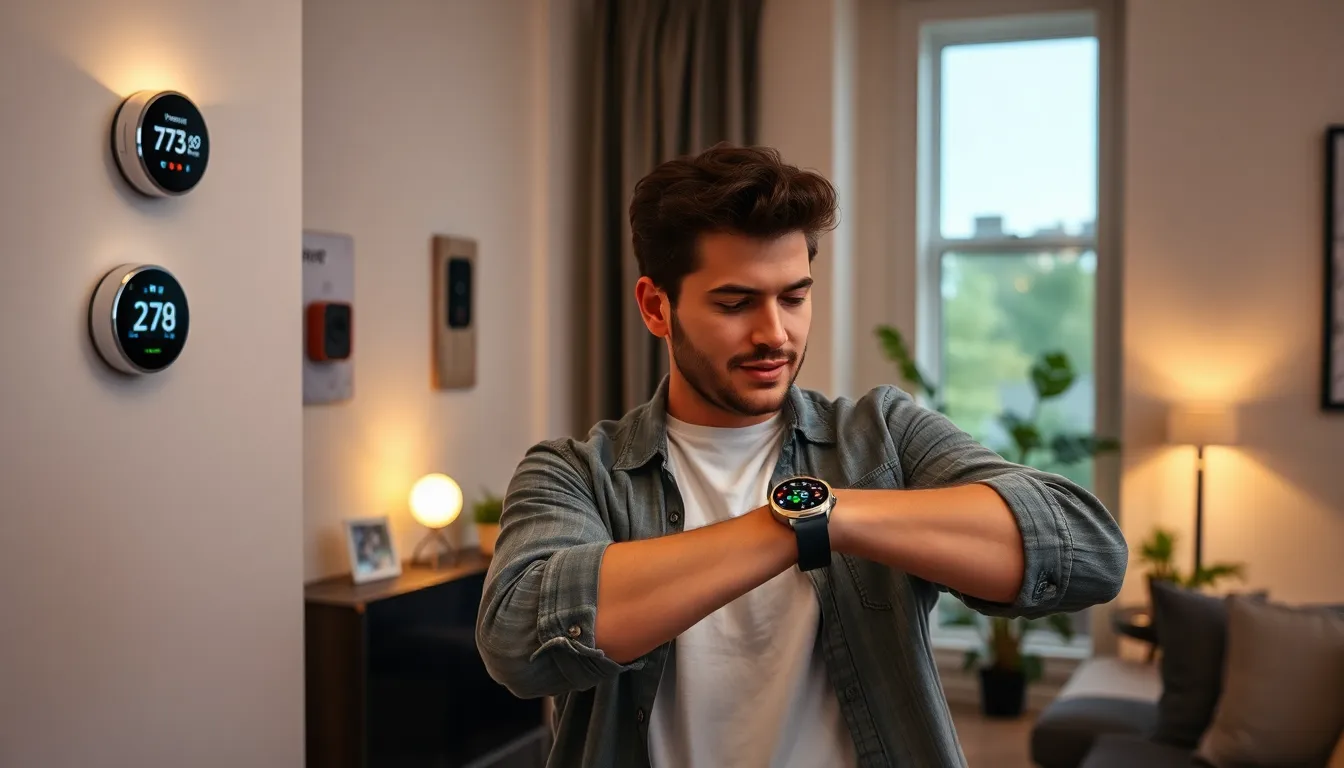In today’s fast-paced world, connected devices are transforming how people interact with technology and each other. From smart home gadgets to wearable fitness trackers, these devices enhance convenience and efficiency, making daily tasks easier and more enjoyable. As the Internet of Things (IoT) continues to expand, the potential for innovation and connectivity grows exponentially.
With billions of devices now online, the implications for personal and professional life are profound. Businesses leverage connected technology to streamline operations and improve customer experiences, while individuals embrace smart solutions for health, safety, and entertainment. Understanding the impact of connected devices is essential for navigating this digital landscape and maximizing their benefits.
Table of Contents
ToggleOverview of Connected Devices
Connected devices refer to electronic gadgets that link to the internet or to one another through various communication protocols. They empower users to monitor, control, and automate processes across multiple domains, including home, workplace, and healthcare.
Types of Connected Devices
- Smart Home Devices: Smart speakers, smart thermostats, and smart lights enable users to control home environments remotely.
- Wearable Devices: Fitness trackers and smartwatches collect and transmit health data, enhancing personal health management.
- Connected Appliances: Refrigerators, ovens, and washing machines streamline household chores, providing efficiency and convenience.
- Industrial IoT Devices: Sensors and connected machinery facilitate real-time monitoring and predictive maintenance in manufacturing.
- Health Monitoring Devices: Remote patient monitoring systems and health apps help healthcare providers track patient conditions and improve outcomes.
Benefits of Connected Devices
- Enhanced Efficiency: Connected devices automate repetitive tasks, allowing for improved productivity.
- Real-Time Data Access: Users gain immediate insights into device performance, supporting informed decision-making.
- Improved Safety and Security: Smart security cameras and alarms enhance protection, reducing risks in personal and commercial spaces.
- Personalized Experiences: Devices learn user preferences, providing tailored recommendations and solutions.
Challenges of Connected Devices
- Privacy Concerns: Increased data collection raises significant privacy issues that require careful management.
- Security Risks: Vulnerabilities in device security can lead to unauthorized access and data breaches.
- Interoperability Issues: Compatibility challenges may arise among devices from different manufacturers, complicating user experiences.
- Dependence on Connectivity: Many connected devices rely heavily on stable internet connections for optimal functionality.
Connected devices continue to shape everyday living and working environments, offering numerous advantages while presenting unique challenges that require consideration.
Types of Connected Devices

Connected devices consist of various categories, each designed to enhance functionality and efficiency in different aspects of life. The major types include smart home devices, wearable technology, and connected vehicles.
Smart Home Devices
Smart home devices integrate with household systems for improved convenience and automation. Examples include smart thermostats that optimize energy usage, smart lights that adjust based on user preferences, and security cameras that provide real-time monitoring. These devices can be controlled remotely via smartphones or voice commands, making daily routines more efficient.
Wearable Technology
Wearable technology includes devices designed to be worn on the body, often for health monitoring and fitness tracking. Examples involve smartwatches that track heart rate, fitness bands that count steps, and smart glasses that display notifications. These gadgets collect data to help users manage their health and fitness goals more effectively.
Connected Vehicles
Connected vehicles utilize internet connectivity to enhance safety and driving experience. Examples feature cars equipped with GPS navigation, real-time traffic updates, and advanced driver-assistance systems (ADAS). These technologies allow vehicles to communicate with each other and with infrastructure, improving safety and reducing congestion on roadways.
Benefits of Connected Devices
Connected devices provide numerous advantages, significantly improving daily life and operational efficiency across various sectors. Their benefits include increased convenience, enhanced security, and valuable data insights.
Convenience and Efficiency
Connected devices streamline everyday tasks. They enable remote monitoring and control, allowing users to automate appliances, lighting, and security systems. Smart home devices like thermostats and lighting systems adjust settings based on user preferences. Wearable technologies track fitness metrics and health indicators, promoting lifestyle adjustments. In professional environments, connected IoT devices facilitate real-time inventory management and equipment monitoring, enhancing productivity and reducing downtime.
Enhanced Security
Connected devices bolster security with advanced monitoring capabilities. Smart cameras and alarms provide instant alerts for unusual activity. Users can access live feeds remotely, offering peace of mind when away from home or the workplace. Additionally, connected locks allow for keyless entry and remote access control, enhancing overall security. Automated lighting systems can deter unauthorized access by mimicking activity within a property.
Data Collection and Analysis
Connected devices generate vast amounts of data, which organizations can analyze for informed decision-making. Health monitoring devices collect user health data, providing insights into patterns and trends. Businesses utilize data from connected machines for predictive maintenance and operational optimization. Enhanced data analytics improve customer experiences by personalizing services based on behavior and preferences, driving engagement and satisfaction.
Challenges of Connected Devices
Connected devices present several challenges that users and organizations must navigate to fully realize their benefits. Key issues include privacy concerns, compatibility issues, and security vulnerabilities.
Privacy Concerns
Privacy becomes a significant issue as connected devices collect extensive user data. Smart home devices, wearables, and health monitoring tools often gather personal information, which can be susceptible to unauthorized access. Data breaches can expose sensitive user information, leading to identity theft and misuse. Organizations, therefore, face pressure to implement stringent data protection measures and ensure compliance with regulations like the General Data Protection Regulation (GDPR).
Compatibility Issues
Compatibility poses another challenge for connected devices. Different manufacturers may use proprietary protocols that limit the seamless integration of devices. Smart home ecosystems can become fragmented, hindering users’ abilities to manage devices from multiple brands effectively. Establishing universal standards for interoperability can help bridge this gap, facilitating broader device compatibility across varying platforms.
Security Vulnerabilities
Security vulnerabilities present mounting risks for connected devices. Many devices lack robust encryption and may contain software weaknesses, making them attractive targets for cyberattacks. Exploited vulnerabilities can compromise personal networks and allow unauthorized access to critical systems. Regular software updates, strong authentication methods, and user awareness initiatives are essential to bolster security defenses against these threats.
Future Trends in Connected Devices
Connected devices will undergo significant advancements, shaping various industries and personal lifestyles. The following trends emerge as pivotal in the evolution of connected technology:
- Increased Integration of AI
AI will enhance connected devices’ capabilities, enabling them to learn user preferences and optimize performance. Devices will become more intuitive, providing personalized experiences and improving automation.
- Expansion of 5G Connectivity
5G technology will facilitate faster data transfer and reduced latency, allowing connected devices to communicate more efficiently. This expansion will support a higher density of connected devices, particularly in urban areas.
With rising concerns about data security, manufacturers will prioritize robust encryption and secure protocols. Increased transparency in data handling practices will become standard as users demand greater control over their information.
- Focus on Sustainability
Connected devices will emphasize energy efficiency and sustainable materials. Innovations will aim to reduce the environmental impact of devices, addressing ecological concerns and promoting eco-friendly practices.
- Interoperability Standards Development
Efforts will increase to establish universal standards that allow seamless communication between devices from different manufacturers. This improvement will enhance user experience, facilitating easier integration across various platforms.
- Growth of Predictive Analytics
Predictive analytics capabilities will improve, enabling devices to anticipate user behavior and maintenance needs. This proactive approach will help users make informed decisions and avoid potential failures.
- Rise of Health Monitoring Devices
The demand for health-focused connected devices will surge, driven by a growing emphasis on wellness and preventive care. Wearable health technologies will enable continuous monitoring, providing valuable insights for personal health management.
- Adoption in Smart Cities
Connected devices will play a crucial role in developing smart cities by enhancing infrastructure and resource management. Applications will include intelligent traffic management systems, waste management optimization, and improved public safety measures.
These trends collectively illustrate the trajectory of connected devices, shaping a more connected, efficient, and secure future.
Connected devices are revolutionizing how individuals and businesses interact with technology. They offer unparalleled convenience and efficiency while enhancing safety and personalization in everyday tasks. As these devices become more integrated into daily life and work environments, their potential continues to expand.
However, challenges such as privacy concerns and security vulnerabilities must be addressed to ensure users can fully benefit from this technology. With ongoing advancements in AI, 5G connectivity, and interoperability standards, the future of connected devices looks promising. As they evolve, these innovations will likely reshape industries and improve quality of life, making it essential for users to stay informed and proactive in adopting these technologies.


